

Although there’s only a handful of games that support DLSS 2.0, you’ll be happy to know that DLSS 2.0 is now available to Unreal Engine 4 developers, so we hope this will accelerate the production and deployment of the next gen games. At the time of writing this, Nvidia announced the pending launch of DLSS 2.1, which supports the highest HDMI 2.1 link rate of 12Gbs/lane across all 4 lanes, and supports Display Stream Compression (DSC) to be able to power up to 8K, 60Hz in HDR. There’s also a new ultra performance mode for 8K gaming, that delivers 8K gaming on the GeForce Nvidia RTX 3090 with a new 9x scaling option.
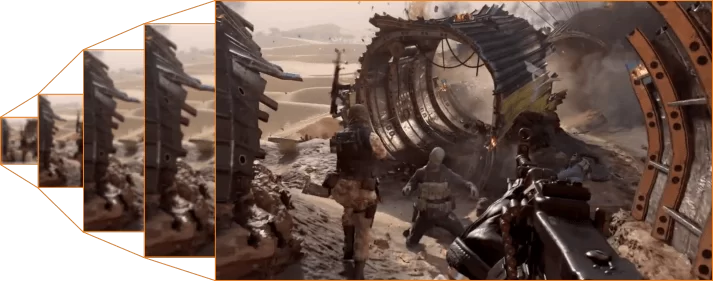
There’s good news for VR gamers as well. DLSS 2.1 will be compatible with PC VR headsets, with the potential of consistent frame-rates of 80 - 90 FPS, however, VR content needs to be developed with DLSS 2.1 in mind, in order for us to benefit from it and currently there’s no VR games out there that we know of to test it.
NVIDIA’s ‘Deep Learning Supersampling’ (AKA; DLSS) technology uses artificial intelligence (AI) to increase the resolution of rendered frames by taking a smaller frame and intelligently enlarging it. The technique has been hailed for its ability to render games with high resolution with much greater efficiency than natively rendering at the same resolution - rendering fewer pixels and then using AI to construct sharp, higher resolution images. Now the latest version, DLSS 2.1, includes VR support and could bring a huge boost to fidelity in VR content.
Example image: Deliver us to the Moon - comparison DLSS ON and DLSS OFF.
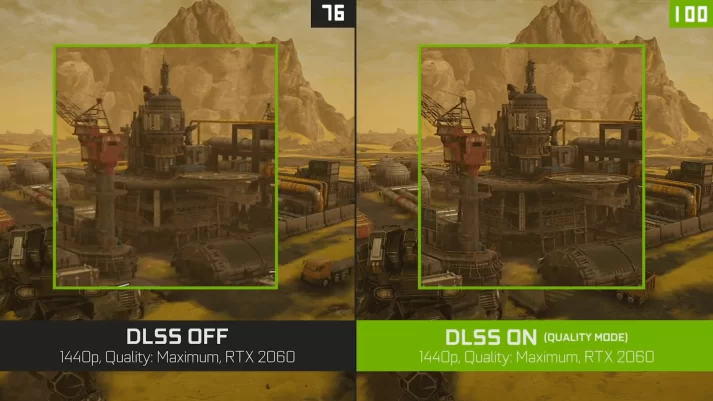
DLSS and DLSS 2.0 is Nvidia’s solution to 8K gaming, or is it? During the presentation made by Nvidia’s CEO, Jensen Huang, on September 1st 2020, he shed some light on DLSS, hyping up 8K gaming on the GeForce RTX 3090, however, there are a few caveats, the main draw-back being that in order to run 8K you need an 8K TV, preferably one that supports HDMI 2.1. This is essential in that it allows a single cable to run 8K at 60Hz in HDR mode. However 8K monitors and TVs are relatively new and come with a hefty price tag - not to mention finding one that supports HDMI 2.1. A proper 8K Monitor or TV that fully supports HDMI 2.1 could set you back as much as £14,000!

Higher Video Resolutions support a range of higher resolutions and faster refresh rates including 8K 60Hz and 4K 120Hz for immersive viewing and smooth fast-action detail, something that’s ideal for gaming.
With HDMI 2.1, this resolution cap is more than doubled by providing 8K and 10K resolution support. It also increases the refresh rate boundary of 4K from 60hz to 120hz, allowing gamers to finally experience 120 frames per second gameplay at 4K resolution.
New 2nd Gen display; Sharp 8M-B80AX1E - the latest cutting edge 8K Monitor. The 8M-B80AX1E is currently the only 8K display to use processing power, as opposed to upscaling, to show highly detailed 8K content. The display is a whopping 80 inches (2,030 mm diagonal) offering true 8K resolution of 7680 x 4320 pixels in 16:9 aspect ratio, which is four-times the resolution of a standard 4K monitor, and a staggering 16-times higher than a Full-HD display.
The Sharp 8M-B80AX1E adheres to DMI2.0a as standard, with four inputs allowing for the sharing of 8K content. However, Sharp has now also added one HDMI 2.1 port, which means gamers will be able to connect devices using a single cable, so reducing setup time considerably. The monitor also meets the needs of an increasing number of businesses, especially those creating ever more sophisticated digital drawings, designs and blueprints using Computer Aided Design.
A great monitor, if you can afford to shell-out £14,000!
We recently spoke with Yusuf Al Hussaini, a tech student with a bachelor's degree in mathematics and currently doing a PHD. So, Yusuf, what's your view on 4K and 8K resolution displays, is it worth it?
Yusuf Al Hussaini
“My current opinion regarding this matter is that 4K and 8K televisions are excellent feats of engineering. However, the satisfaction delivered by an LCD monitor can barely exceed the power of the technology that is used to provide or generate the content displayed on it. The greater the resolution, the greater the hardware requirements needed to produce each frame in sequence. TVs are like windows into other places, the bigger the window, the better the view. The human eye contains several million cones, most of which are positioned in the retina. The combined picture formed from both eyes yields a resolution of approximately 576 megapixels in digital terms. The focal viewing point consists of around 7 megapixels meaning that for a complete viewing experience, no more than 4K is needed at a distance, and no more than 8K is needed when viewing up close. Therefore, as much as I agree with the idea that 8K TV screens can provide a satisfactory experience for some viewers, I do not think that resolutions beyond 10K are worth investing in, as they are practically impossible to distinguish from their 8K rivals.”
Using Nvidia’s Neural Graphics Framework (NGX), the DLSS deep neural network is trained on a Nvidia DGX-powered supercomputer. So what does this mean?
Essentially DLSS 2.0 has two main inputs into its AI network:
Okay, so how does that work then? Good question! Motion vectors inform us which elements in the scene are moving from frame-to-frame. These vectors can then be applied to the previous high resolution output to estimate what the next frame will look like. Nvidia refers to this process as ‘temporal feedback’, as it uses past data to inform future data. That’s just a small part of its AI.
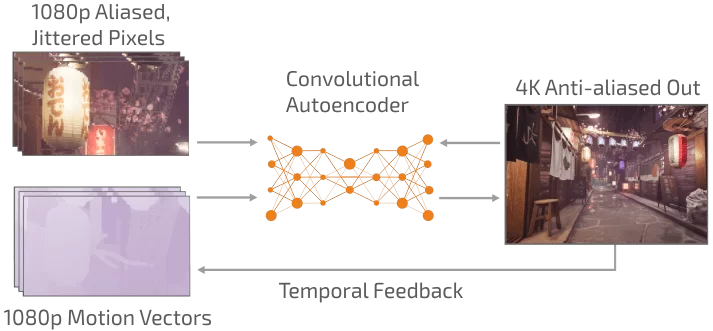
Nvidia’s DLSS 2.0 architecture captures a low resolution (current frame) and the high resolution previous frame to decide on a pixel-by-pixel basis how to produce a higher quality ‘now’ frame. But it goes deeper than that!
During the training process (part of the DLSS 2.0 AI process) the output frame, image then, is compared to an offline rendered, super-high quality 16K reference image - that’s right, a whopping 16K!. The difference between the two are then compared and collaborated, returning to the network in order for it to continue to learn and improve its results. It’s quite amazing how fast this all happens, in that the process is rapidly repeated tens of thousands of times on the supercomputer until the network reliably outputs high quality, high resolution images. Okay, so what happens next?
Once the network is trained, NGX sends the AI model to your RTX enabled PC via Game Ready Drivers (GRD) and over the air (OAT) updates. With Turning’s Tensor Cores having the ability to deliver up to 110 teraflops of dedicated horsepower, the DLSS network can be simultaneously run in real-time, even with the most demanding 3D game. We need to thank those Tensor Cores and Nvidia’s Turing for that.
Nvidia arduously continues to work on DLSS and additional, newer, DLSS features and integrations into popular games. So the future looks good for gamers:
The GeForce RTX 3000 Series graphics cards all utilise Nvidia’s 2nd generation Ray Tracing Cores and 3rd Gen Tensor Cores, and in tandem with enhanced DLSS run even faster!
These are just a handful of games we can expect to see that will support DLSS. Boundary, Bright Memory: Infinite, Call of Duty: Black Ops Cold War, Cyberpunk 2077, Fortnite and Watch Dogs: Legion.
For those of you who own the Nvidia RTX 3090, Nvidia is introducing a new DLSS Ultra Performance Mode specifically for 8K gaming, games such as Boundary, Justice and Minecraft to mention a few.
You’ll also be happy to know that the latest version of DLSS also improves image quality where the details are a little more enhanced. There appears to be noticeable improvements on the clarity of text as well as flat textured game elements, such as posters and maps.
The following images show additional examples of improvements from the original version of DLSS to the updated version of DLSS 2.0.
Deliver Us The Moon’s built-in Temporal Anti-Aliasing technique. On closer examination, DLSS 2.0 even shows subtle improvements, with better fidelity on the intricate cyclone fencing. Not impressed? Check out the videos further down.

DLSS 2.0 enabled, compared to Wolfenstein: Youngblood’s highest-quality TAA mode: Pay particular attention to the Aerial's on the roof-top.
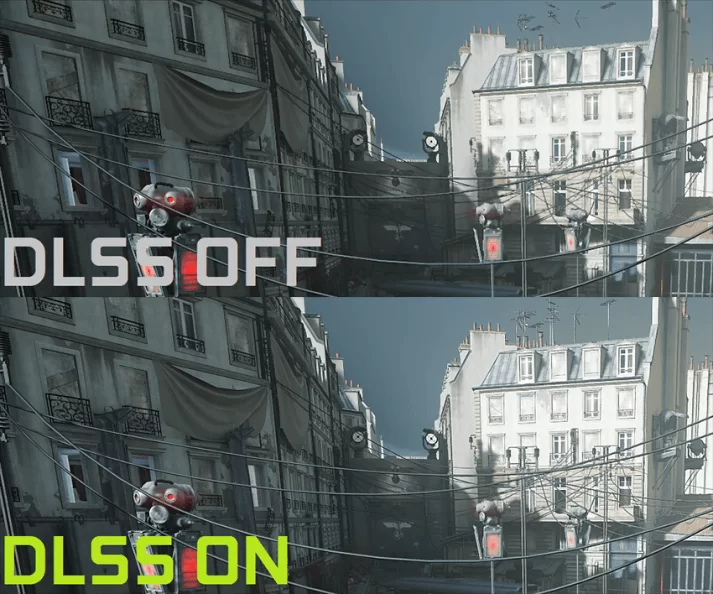
See DLSS in action - video side-by side comparison...
Deliver Us To The Moon performance increased - leaping by 60% in a single bound with Nvidia’s DLSS 2.0 enabled.
Well that’s about it on DLSS and DLSS 2.0, I hope I explained everything well enough to give you the general idea on what DLSS is and how it works.
If you have any questions or simply want to provide some feedback, we’d love to see what you have to say - please leave a comment in the section below.


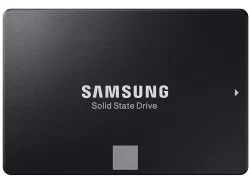

DLSS and DLSS 2.1